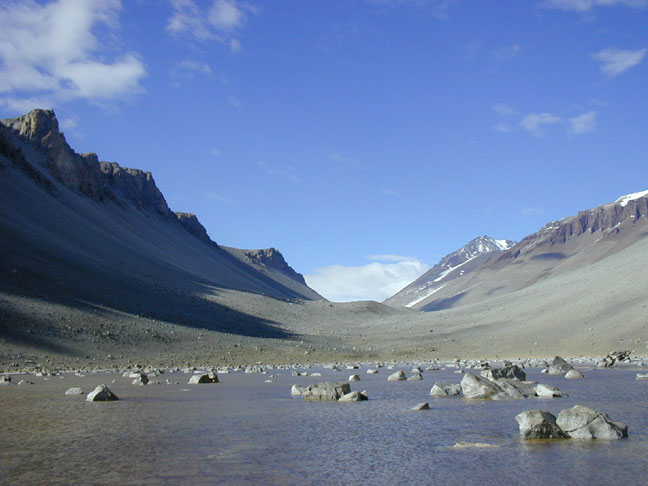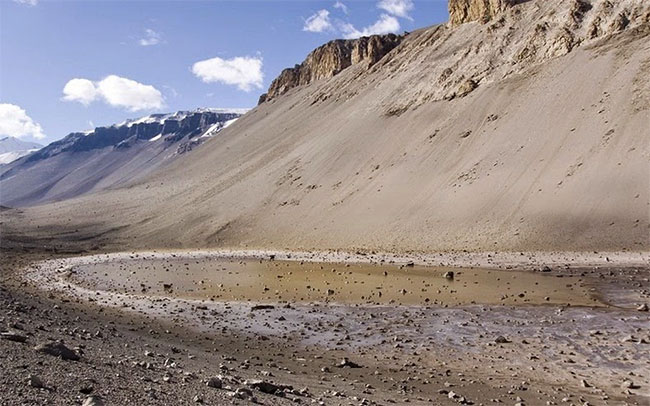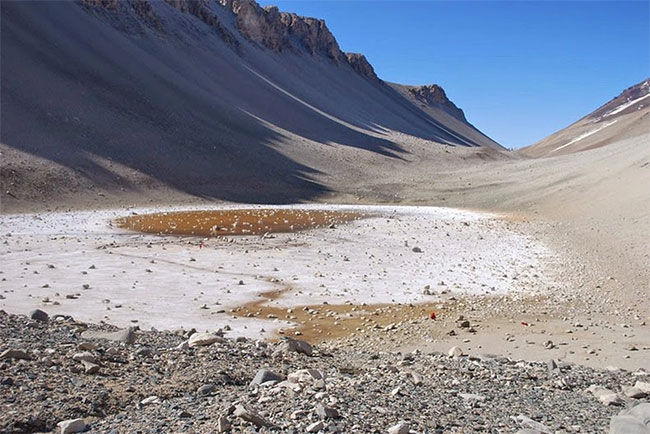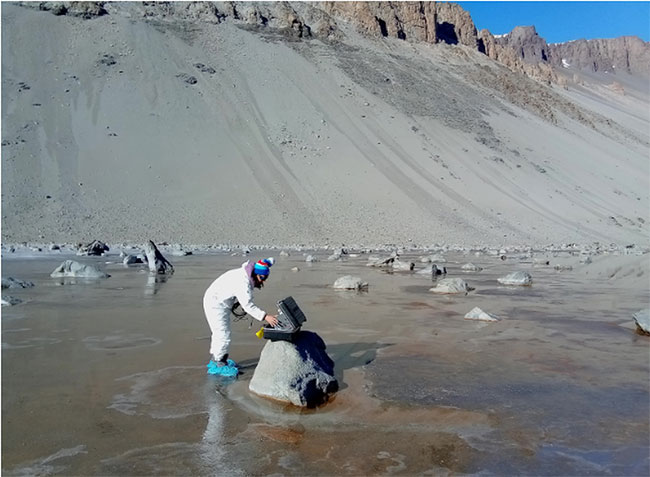Scientists have long been puzzled by Don Juan Pond, located in the coldest and driest part of Antarctica, which remains unfrozen even when temperatures drop to -50 degrees Celsius.
Never Freezes Even at -50 Degrees
At the foot of the Transantarctic Mountains (a range of mountains that rises and stretches across Antarctica), in the McMurdo Dry Valleys, lies a very peculiar pond known as the Don Juan Pond. Discovered for the first time in 1961, it was named after the helicopter pilots of the expedition, Donald Roe and John Hickey.
Even during winter, when almost everything in Antarctica freezes, Don Juan Pond remains liquid. Even more remarkably, in the arid conditions of Antarctica, where annual rainfall is only about 50 mm, scientists have yet to determine the source of water for Don Juan Pond.

Don Juan Pond is a peculiar pond that does not freeze even at -50 degrees Celsius. (Photo: Baidu)
Although Don Juan Pond is twice the size of an Olympic swimming pool and more than 10 cm deep, it is incredibly famous worldwide. Despite its depth of just over 10 cm, Don Juan Pond resembles a puddle containing a white liquid rather than a typical pond. This peculiarity prompted scientists from the University of Washington to investigate precisely what makes its water remain unfrozen at such low temperatures.
Ronald Sletten, a professor in the Earth Sciences department at the University of Washington, stated: “Don Juan Pond is exceptionally unique. Our goal is to better understand the components of its water and its water source.”
Sletten and his team spent six weeks in Antarctica studying Don Juan Pond, its flow, and the surrounding environment. For the scientific team, this research is significant in understanding life on other planets, particularly Mars, since the environment of the McMurdo Dry Valleys in Antarctica shares many similarities with Mars, being cold, salty, and dry. This research was supported by the National Science Foundation (NSF), which also manages the U.S. Antarctic Program and NASA.

Don Juan Pond has a salinity of over 47.4%. (Photo: Baidu)
According to the research findings, Don Juan Pond is a hypersaline pond with salinity levels exceeding those of ocean water (which is about 3.5%). According to Professor U.T. Hammer (1924), author of the book “Ecosystems of Saline Lakes Worldwide,” the saltiest body of water on Earth is Don Juan Pond. Don Juan Pond has a salinity of 47.4%, nearly 1.5 times that of the Dead Sea and 13.5 times that of the ocean. Thus, even though it is located in one of the coldest areas of Antarctica, it never freezes, even when temperatures drop to -50 degrees Celsius.
Researchers believe that Don Juan Pond’s high salinity is due to the salt extracted from groundwater beneath the Olympus and Asgard mountain ranges. Additionally, it receives minerals dissolved from the rocks surrounding the pond. However, geologists from Brown University have shown that Don Juan Pond acquires its salt from rainwater rather than groundwater.
Water Supply from the Groundwater System
Furthermore, this study indicates that Don Juan Pond is supplied with water from a deep groundwater system. According to their calculations, every six months, the groundwater system beneath rises and flows to the surface, forming Don Juan Pond.

It turns out that the water of Don Juan Pond comes from the underground groundwater system. (Photo: Baidu)
The research team created a model to calculate how Don Juan Pond could have water under such arid conditions. Their model was based on two scenarios: one where water is supplied through the groundwater system and the other where it flows down from the mountains. The results of this experiment indicated that water could only be supplied from the underground groundwater system.
Recent studies have confirmed the presence of water on the surface of Mars. This suggests the possibility of life on Mars and that humans could potentially settle there long-term. Coupled with the findings from the Don Juan Pond study, geologists are excited because understanding how this body of water forms may help them determine the origins of water on Mars.
Life in the Saltiest Place on Earth
Researchers from Penn State University have discovered traces of microbial life in Don Juan Pond. They found thin organic layers, 2-5 mm thick, beneath the water’s surface in the western part of Don Juan Pond. Specifically, the research team identified a microbial community that includes heterotrophic forms and prokaryotic organisms, as well as fungi in the pond.

Scientists have found a microbial community beneath the surface of Don Juan Pond. (Photo: Baidu)
However, they are still researching whether these microorganisms are truly thriving there or if they are simply microorganisms carried by the wind from elsewhere.
Corien Bakermans, a microbiologist from Penn State University, stated: “Don Juan Pond is considered an example of a place on Earth where we believe life exists, but we cannot definitively determine its presence.“


















































